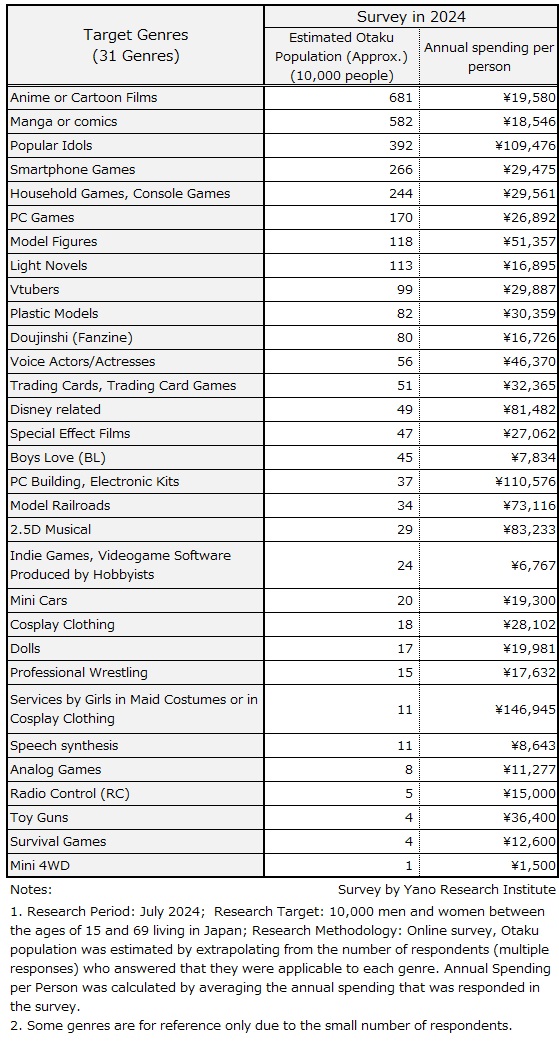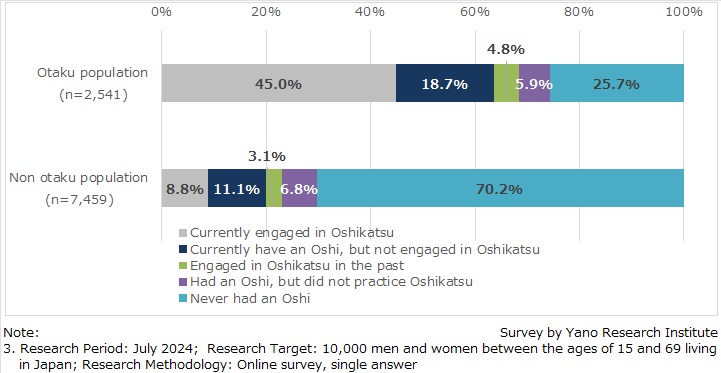No.3668
Consumer Survey on Otaku in Japan: Key Research Findings 2024
Otaku Population by Genre At Highest for “Anime”/ 63.7% of Otaku Have “Oshi”
Yano Research Institute (the President, Takashi Mizukoshi) has conducted a consumer survey on the domestic Otaku market and analyzed the estimated population, attributes (characteristics) and activity statuses of Otaku by genre (31 genres). This press release highlights a part of the survey results.


Summary of Research Findings
This consumer survey was conducted in July 2024 to 10,000 men and women between the ages of 15 and 69 living in Japan, and the number of Otaku population for each genre was estimated based on the survey results, i.e., the number of those who recognized themselves as Otaku and the number of those who responded that they were recognized as Otaku by third parties. The number of otaku for “anime or cartoons” was approximately 6,810 thousand, the largest number among 31 genres in this survey, followed by “manga or comics” at 5,820 thousand, “popular idols”at 3,920 thousand, “smartphone games” at 2,660 thousand, and “household games, console games” at 2,440 thousand.
For the annual spending on otaku activities by those who identified themselves as otaku, the largest number of responses was “from 10,000 to less than 50,000 yen”. The average spending per year for 31 genres was 37,579 yen (including those who answered 0 yen). Note that some genres are for reference only due to the small number of respondents.
Noteworthy Topics
Most Popular Oshi Subject for Otaku Population Is Japanese Pop Idols While That for Non-Otaku Population Is Musicians
When both the otaku and non-otaku populations were asked about whether or not they had "oshi (*1)" or "fave," those respondents who answered that they had oshi (total number or respondents “currently engaged in 'oshikatsu' activities” and “have 'oshi', but not engaged in 'oshikatsu' activities”) accounted for 63.7% of the otaku population, while they accounted for 19.9% of the non-otaku population. The otaku population is overwhelmingly engaged in oshikatsu.
When asked about the subject of oshi among those who have oshi or have had oshi in the past, the largest number of responses among the otaku population was “Japanese idols” at 22.5%, followed by “anime or manga characters” at 21.3%, and “musicians” at 11.0%.
On the other hand, the largest number of responses among the non-otaku population was “musicians” at 23.6%, followed by “Japanese idols” at 19.4%, and “anime or manga characters” at 10.4%.
The top three subjects of oshi were the same for the otaku and non-otaku populations, but “anime or manga characters” for the otaku population and “musicians” for the non-otaku population earned more than 10 points more than their counterparts.
*1) In this survey, “oshi” refers to the subject or favorite of followers or fans to support or the subject that fans want more people to know attractiveness. "oshikatsu" refers to the voluntary activity of fans or followers to support their favorites for pleasure. The concept of “oshi” can be a person, a team, a work, a character, a facility (e.g., Disney Land), etc. was shared among respondents before they have answered to the survey questions.
*2) Regarding “Oshikatsu (Spending on Oshi/Favorites) Status by Otaku and Non-Otaku Population”, the survey was aggregated for 1,889 otaku and 2,225 non-otaku people, excluding those who previously answered that they had never had oshi in their lives.
Research Outline
2.Research Object: 10,000 men and women at the ages between 15 and 69 living in Japan. (Of these people, those who recognized themselves as “Otaku” or for those responded that they are recognized from the third party as “Otaku” are defined as “Otaku” and targeted for detailed research.)
3.Research Methogology: Online survey
About Consumer Survey on Otaku
This consumer survey was performed in July 2024 to 10,000 men and women at the ages between 15 and 69 living in Japan. Based on the survey results, those who recognized themselves as “otaku” or those responded that they were recognized from the third party as “otaku” were defined as otaku here. In addition, otaku in this research refers to the following 31 genres and has analyzed the attributes (characteristics) and activities by each genre. This press release has focused on a part of such analytic results.
List of 31 target genres:
1. Anime or Cartoon Films, 2. Manga Comics, 3. Light Novels, 4. Doujinshi (Fanzine), 5. Plastic Models, 6. Model Figures, 7. Dolls, 8. Model Railroads, 9. Popular Idols, 10. Professional Wrestling, 11. Cosplay Clothing, 12. Services by Girls in Maid Costumes or in Cosplay Clothing, 13. Smartphone Games, 14. Household Games/Console Games, 15. PC Games, 16. Indie Games, Videogame Software Produced by Hobbyists, 17. Analog Games, 18. Trading Cards, Trading Card Games, 19. Boys Love (BL), 20. Speech/Vocal Synthesis, 21. Toy Guns, 22. Survival Games, 23. Radio Control (RC), 24. Mini 4WD, 25. Mini Cars, 26. Voice Actors/Actresses, 27. PC Building, Electronic Kits, 28. Disney related, 29. VTubers, 30. Special Effect Films, 31. 2.5D Musical
<Products and Services in the Market>
1. Anime or Cartoon Films, 2. Manga Comics, 3. Light Novels, 4. Doujinshi (Fanzine), 5. Plastic Models, 6. Model Figures, 7. Dolls, 8. Model Railroads, 9. Popular Idols, 10. Professional Wrestling, 11. Cosplay Clothing, 12. Services by Girls in Maid Costumes or in Cosplay Clothing, 13. Smartphone Games, 14. Household Games/Console Games, 15. PC Games, 16. Indie Games, Videogame Software Produced by Hobbyists, 17. Analog Games, 18. Trading Cards, Trading Card Games, 19. Boys Love (BL), 20. Speech/Vocal Synthesis, 21. Toy Guns, 22. Survival Games, 23. Radio Control (RC), 24. Mini 4WD, 25. Mini Cars, 26. Voice Actors/Actresses, 27. PC Building, Electronic Kits, 28. Disney related, 29. VTubers, 30. Special Effect Films, 31. 2.5D Musical
Published Report
Contact Us
The copyright and all other rights pertaining to this report belong to Yano Research Institute.
Please contact our PR team when quoting the report contents for the purpose other than media coverage.
Depending on the purpose of using our report, we may ask you to present your sentences for confirmation beforehand.